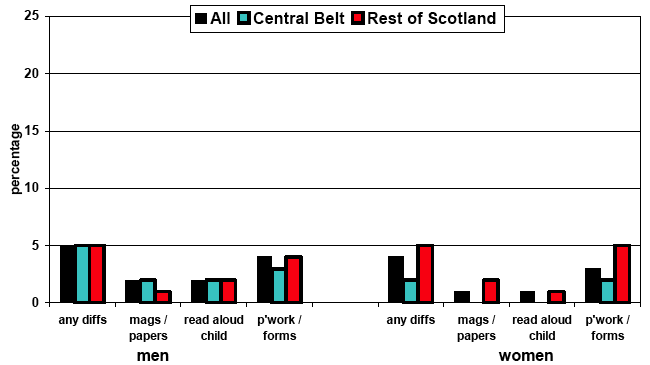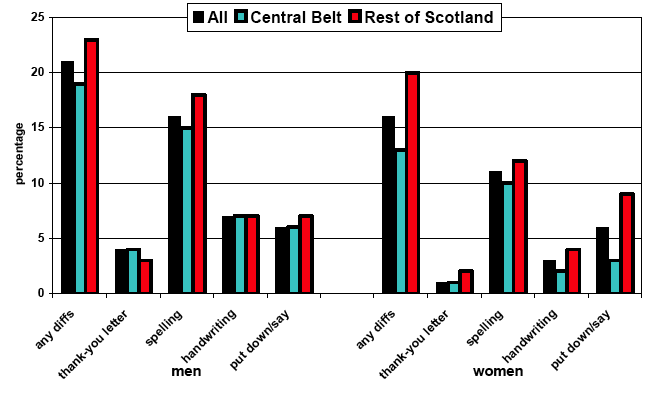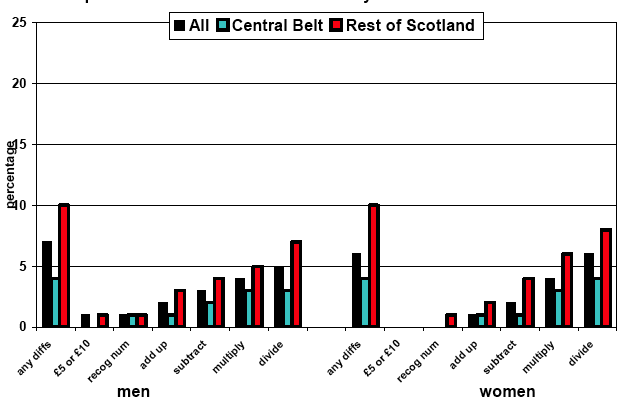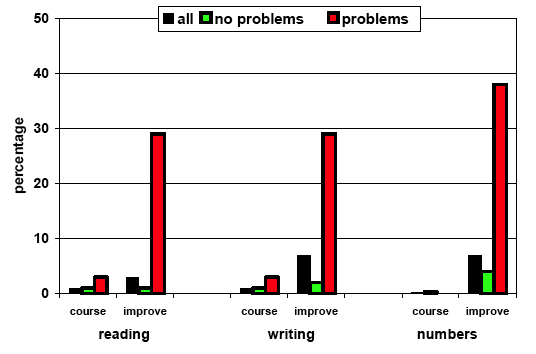New Light on Adult Literacy and Numeracy in Scotland: Evidence from the 2004 survey of the 1970 British Cohort Study (BCS70)
This report gives the results of a separate analysis for Scotland of literacy and numeracy data collected in the 1970 British Cohort Study at age 34. It relates performance in these skills to a wide range of other features of Scottish cohort members' lives.
Chapter 2 Self-reported reading, writing and number difficulties
It has been argued that self-appraisal of a difficulty may in fact be the more important indicator of the need for improvement than the objective measure itself because it is closely linked to the motivation to change 7. Fundamental to raising adult literacy and numeracy levels is for people's recognition that they have poor skills (latent need), and then to perceive these poor skills as a difficulty (expressed need). However, much need remains invisible, that is, people with poor skills do not perceive they have difficulties and thus have no motivation to improve their skills. In research carried out for the Basic Skills Agency ( BSA) using birth cohort data collected in the 1990s, acknowledgement of difficulties with basic skills was low, barely exceeding 5%, even among those identified by the literacy and numeracy assessments 8 as having very poor skills. The results in the original New Light pointed to a continuing low awareness of literacy and numeracy difficulties among cohort members, being lowest of all among those living in Scotland, with only a moderate association between awareness of difficulties and interest in, and attendance at, learning. Between January 2004 and March 2005, almost the entire period of fieldwork for the 2004 survey, the first Big Plus awareness raising campaign ran in Scotland. 9. The findings here will be particularly relevant to seeing how effective this campaign had been on cohort members' motivation to improve skills and therefore likely take-up in the future.
In an attempt to capture more specific difficulties cohort members might be experiencing, all questions on skills difficulties included in 2004 were for the first time put to all participating cohort members 10. This amounted to three questions on reading difficulties, four on writing difficulties and six on number and maths difficulties 11. We look first at levels of self-reported difficulties with no reference to the assessed skills level of cohort members and then at the relationship between the two measures.
Levels of self-reporting reading, writing or numberwork difficulties in Scotland
In table 2.1 we compare the percentage of cohort members who reported difficulties with any of the three reading, four writing or six numberwork tasks by their Scottish profile 12. It seems that despite the Big Plus campaign, men and women living in Scotland in 2004, or indeed those who had been born there were less likely to self-report difficulties with one literacy or numeracy, compared to men and women who had no Scottish heritage.
Table 2.1: % of cohort members reporting difficulties by their Scottish profile
Born & live in Scotland |
Born in Scotland |
Live in Scotland |
Born & Live elsewhere |
|
|---|---|---|---|---|
Any reading difficulty? |
4% |
6% |
3% |
8% |
Any writing difficulty? |
19% |
20% |
15% |
26% |
n(100%) |
711 |
113 |
95 |
7707 |
Any numberwork difficulty? |
6% |
5% |
7% |
11% |
n(100%) |
736 |
115 |
95 |
7941 |
In Tables 2.2a, 2.2b and 2.2c we look in more detail at the specific difficulties reported by cohort members living in Scotland at the time of interview in 2004. We distinguish between those who live in the 'Central Belt' and the 'Rest of Scotland'. Writing difficulties were the most widely reported (18%) while difficulties with reading were reported least often (4%). Although the differences were not statistically significant 13, residents in the Central Belt were slightly less likely those living in other (predominantly more remote) parts of Scotland to self report difficulties with literacy or numeracy.
Table 2.2a: % reporting difficulties in response to the individual reading questions
READING |
Overall |
Central Belt |
Rest of Scotland |
|---|---|---|---|
Any reading difficulty? |
4% |
4% |
5% |
Can you usually read and understand what is written in a magazine or newspaper? |
1% |
1% |
1% |
Can you read aloud to a child from a children's storybook? |
1% |
1% |
1% |
Can you usually read and understand any paperwork or forms you would have to deal with? |
3% |
4% |
3% |
n(100%) |
865 |
492 |
373 |
Table 2.2b: % reporting difficulties in response to the individual writing questions
WRITING |
Overall |
Central Belt |
Rest of Scotland |
|---|---|---|---|
Any writing difficulty? |
18% |
16% |
21% |
Can you write a letter to a friend to thank them for a gift or to invite them to visit? |
2% |
2% |
2% |
When you try to write something do you find it difficult to spell some words correctly? |
13% |
12% |
15% |
Do you find it difficult to make your handwriting easy to read? |
5% |
5% |
5% |
Do you find it difficult to put down in words what you want to say? |
6% |
5% |
8% |
n(100%) |
865 |
492 |
373 |
Table 2.2c: % reporting difficulties in response to the individual number questions
NUMBERWORK |
Overall |
Central Belt |
Rest of Scotland |
|---|---|---|---|
Any number / maths difficulty? |
7% |
4% |
10% |
When you buy things in shops with a five or ten pound note, can you usually tell if you have the right change? |
0% |
0% |
0% |
When you have to do things with numbers do you find it difficult to recognise numbers when you see them? |
1% |
1% |
1% |
Do you ever have difficulty adding up? |
2% |
1% |
2% |
Do you ever have difficulty with subtraction - that is taking one number away from another? |
2% |
1% |
4% |
Do you ever have difficulty with multiplication? |
4% |
3% |
5% |
Do you ever have difficulty with division? |
5% |
3% |
8% |
n(100%) |
891 |
505 |
386 |
As Table 2.2a shows, of the three aspects of reading covered, difficulties with form-filling and similar paperwork were reported most frequently (3%). Of the four writing questions (Table 2.2b) spelling was the most widely reported difficulty (13%) and, not unexpectedly, of the six questions to do with numbers and mathematical calculations (Table 2.2c), most cohort members reported difficulties with division (5%). Cohort members living outside the Central Belt were slightly more likely to self-report difficulties with spelling, putting down in words what they wanted to say and the four mathematical calculations.
Figures 2.1a, 2.1b and 2.1c show the percentages of men and women who reported each of a number of specific situations in which they had reading, writing or number difficulties by current location in Scotland. For the three aspects of reading there were very little differences between percentages of men and women who reported difficulties, but more women living outside the Central Belt tended to report difficulties. Differences between men and women reporting difficulties with each of the four aspects of handwriting were more noticeable (Figure 2.1b), particularly for spelling (16% men, 11% women), with men living outside the Central Belt the most likely of all to report difficulties (18% men, 12% women).
For number and maths difficulties (Figure 2.1c) there were virtually no differences between percentages of men and women reporting difficulties. However, men and women living outside the Central Belt area were more than twice as likely as those living within the Central Belt to report overall difficulties (10% to 4% for both men and women) and with each of the mathematical operations. Women living outside the Central Belt were the most likely of all to report difficulties with division (8% to 4% in the Central Belt). The results here do not support the gender-typical stereotyping that was found in the New Light report where more men perceive difficulties associated with written communication and more women report difficulties with the more advanced mathematical operations (multiplication and division).
Figure 2.1a: % men and women who reported specific reading difficulties by where live in Scotland

Figure 2.1b: % men and women who reported specific writing difficulties by where live in Scotland

Figure 2.1c: % men and women who reported specific number / maths difficulties by where live in Scotland

Literacy and numeracy learning and the wish to improve skills
4% of all men and women in BCS70 had been on a course to help them improve their reading, writing or number and maths calculations however, this fell to just 1% of men and 2% of women living in Scotland in 2004. In comparison to those who had been born in Scotland, men and women who had moved to Scotland were more likely to report attendance on a course (3% to 1%), as were women outside of the Central Belt (3%). Figure 2.2 shows that even among the men and women who reported skills difficulties, no more than 3% also reported that they had been on a reading or writing course in the last four years to help overcome these difficulties. Less than 1% had been on a course to help with their numbers. This is in line with the acknowledgment that opportunities for learners to improve their numeracy have been underdeveloped, and that literacy programmes have dominated provision in Scotland 14.
However, more than 1 in 7 (13%) of all men and women wanted to improve their reading, writing or number skills, with more men reporting that they wanted to improve their reading skills (4% men, 2% women) and writing skills (9% men, 6% women) and women slightly more likely their grasp of numbers (6% men, 7% women). More men born in Scotland wanted to improve any of these skills, compared to those who had moved to Scotland later on (15% to 3%). Compared to those within the Central Belt, more men and women living in other parts of Scotland wanted to improve their skills: 1% to 3% reading, 5% to 7% writing, 6% to 9% numbers.
Among men and women who reported reading, writing or number difficulties more than 1 in 3 wanted to improve at least one of their skills. More specifically, Figure 2.2 shows that among both men and women reporting reading or writing difficulties, 29% reported that they wanted to improve their skills. Among the men and women who reported difficulties with some aspect of numberwork, as many as 38% wanted to improve their skills. By comparison, among the respondents who did not acknowledge difficulties, very small proportions wanted to improve their skills (usually less than 4%).
Figure 2.2: % men and women who had been on a course or wanted to improve their skills, by self-reported difficulties

Summary self-reported difficulties
The results point to a continuing low self-awareness of literacy and numeracy difficulties which is not surprising among adults, The very low number of adults who report difficulties with reading, writing or numbers and have actually been on a course to help improve their skills - just 3% to improve reading or writing and no-one to improve numberwork - needs to be set against the significant proportion of those acknowledging a difficulty who say that they want to improve their skills (29% reading or writing, 38% numberwork).This first points to challenges and opportunities that the Adult Literacy and Numeracy strategy in Scotland needs to address. The Big Plus campaign obviously stimulated awareness of difficulties in some adults, but the unmet need to improve skills - particularly number skills - suggests that further campaigns and learning opportunities are required that match the specific needs identified by potential learners.
There is a problem
Thanks for your feedback